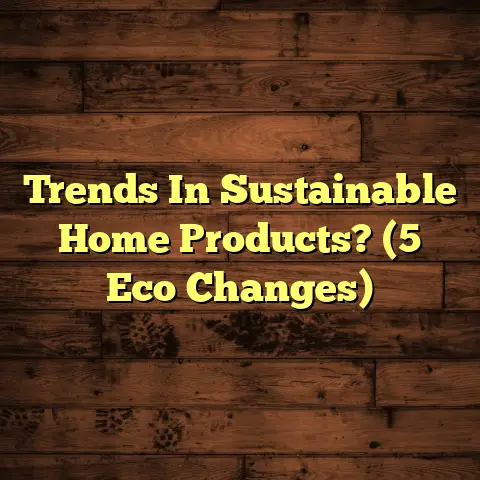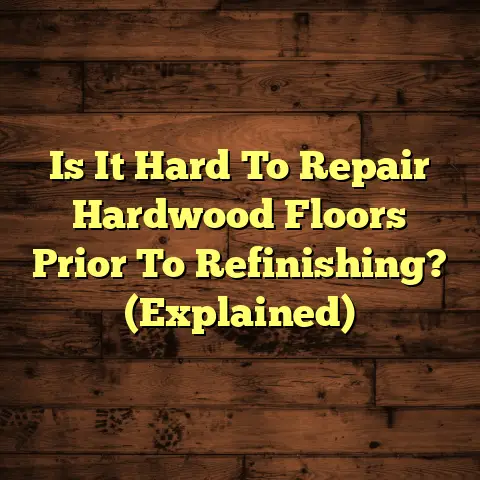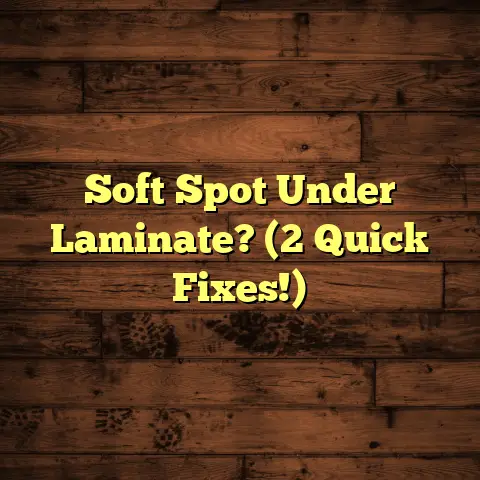Office Chair Floor Protector? (8 Top Choices Now!)
Have you ever dreamed of transforming your office into an oasis of comfort and style, where your flooring is perfectly protected and your productivity soars? I know I have! As a flooring contractor, I’ve seen firsthand the damage an office chair can inflict. Let’s dive into how to keep your floors looking pristine.
Section 1: The Importance of Office Chair Floor Protectors
As someone who deals with flooring day in and day out, I can’t stress enough how important it is to protect your floors, especially in an office environment.
Think about it: office chairs are constantly rolling, pivoting, and shifting. This repetitive motion can wreak havoc on your flooring.
- Scratches: Those little nicks and lines that appear over time.
- Dents: Especially on softer woods or vinyl.
- Wear: The general fading and thinning of the floor’s finish.
I’ve seen beautiful hardwood floors ruined by years of unprotected chair use. It’s a sad sight, and an expensive fix.
But the good news is, it’s easily preventable! Floor protectors are a simple, cost-effective solution that offers several benefits:
- Extending the Life of Your Flooring: By preventing damage, you’re saving yourself from costly repairs or replacements down the road.
- Maintaining Aesthetic Appeal: Nobody wants a workspace that looks worn and damaged. Protectors keep your floors looking their best.
- Improving Mobility: Some protectors, especially mats, can actually make it easier to move your chair around, reducing strain and increasing productivity.
I always tell my clients: “An ounce of prevention is worth a pound of cure.” Invest in floor protectors, and you’ll thank yourself later.
Section 2: Types of Office Chair Floor Protectors
The market is flooded with options, so let’s break down the most common types of office chair floor protectors. I’ll give you my honest take on each, based on my experience.
-
Plastic Mats: These are probably the most common type. They’re typically made from PVC or polycarbonate.
- Pros: Affordable, readily available, and offer decent protection.
- Cons: Can be brittle and crack over time, especially under heavy use. They can also yellow or discolor. Aesthetically, they’re not always the most appealing.
- Best For: Low-pile carpets or hard floors in low-traffic areas.
-
Vinyl Mats: Similar to plastic mats, but often more flexible and durable.
- Pros: More resistant to cracking and yellowing than plastic mats. Easier to clean.
- Cons: Can still show wear and tear over time. Not always the most eco-friendly option.
- Best For: Hard floors or medium-pile carpets in moderate-traffic areas.
-
Carpet Protectors: Specifically designed for carpets, these usually have small cleats or grippers on the underside to prevent them from shifting.
- Pros: Protects carpets from wear and tear, prevents chairs from sinking into the carpet.
- Cons: Not suitable for hard floors. Can be difficult to clean thoroughly.
- Best For: Any type of carpeting.
-
Wooden and Bamboo Protectors: A more stylish and eco-friendly option.
- Pros: Aesthetically pleasing, durable, and sustainable (especially bamboo).
- Cons: More expensive than plastic or vinyl. Can be scratched or dented. May require special cleaning.
- Best For: Hard floors in offices where appearance is a top priority.
-
Glass Mats: These are the premium option. Made from tempered glass, they’re incredibly durable and stylish.
- Pros: Extremely durable, scratch-resistant, and easy to clean. Aesthetically appealing.
- Cons: The most expensive option. Can be heavy and difficult to move.
- Best For: Hard floors in high-end offices or home offices where you want a sleek, modern look.
I’ve personally used all of these types in various projects, and I can tell you that the “best” one really depends on your specific needs and budget.
Section 3: Factors to Consider When Choosing a Floor Protector
Okay, so now you know the different types. But how do you choose the right one for your office? Here are the key features I always consider:
-
Size and Shape: Measure the area where your chair moves. You want a protector that’s large enough to cover the entire range of motion. Consider the shape of your desk and office layout when choosing between rectangular, square, or even custom-shaped protectors.
-
Thickness: The thicker the protector, the better the protection. However, thicker protectors can also be more difficult to roll over. Find a balance that works for you.
-
Material: As we discussed earlier, the material affects durability, aesthetics, and price. Choose a material that’s appropriate for your flooring type and your budget.
-
Non-Slip Features: Especially important for hard floors. Look for protectors with a textured surface or a non-slip backing to prevent them from sliding around.
-
Eco-Friendliness: If sustainability is a concern, look for protectors made from recycled materials or sustainable sources like bamboo.
-
Warranty and Customer Service: A good warranty shows that the manufacturer stands behind their product. Also, check reviews to see how responsive their customer service is.
These factors all play a role in the effectiveness and longevity of your floor protector. Don’t just grab the cheapest option; do your research and choose wisely!
Section 4: Top 8 Choices for Office Chair Floor Protectors
Alright, let’s get down to the nitty-gritty. Based on my experience and extensive research, here are my top 8 picks for office chair floor protectors:
-
AmazonBasics Polycarbonate Office Chair Mat:
- Description: A classic, affordable polycarbonate mat.
- Key Features: Durable, clear, suitable for hard floors, and comes in various sizes.
- Ideal Use Cases: Home offices or low-traffic areas with hard floors.
- Pricing Information: Typically under $50.
- Customer Reviews: Generally positive, with users praising its durability and value for money. Some complain about it being difficult to unroll initially. AmazonBasics Polycarbonate Office Chair Mat
-
Floortex Evolve Recycled Polycarbonate Chair Mat:
- Description: Made from recycled polycarbonate, this mat is a more eco-friendly option.
- Key Features: Durable, clear, suitable for hard floors, and made from recycled materials.
- Ideal Use Cases: Offices where sustainability is a priority.
- Pricing Information: Around $60-$80.
- Customer Reviews: Users appreciate the eco-friendly aspect and the mat’s durability. Some find it a bit pricey compared to other polycarbonate mats. Floortex Evolve Recycled Polycarbonate Chair Mat
-
Lorell Tempered Glass Chair Mat:
- Description: A premium glass mat that offers exceptional durability and style.
- Key Features: Scratch-resistant, easy to clean, and adds a modern touch to any office.
- Ideal Use Cases: High-end offices or home offices where aesthetics are important.
- Pricing Information: $200-$400.
- Customer Reviews: Overwhelmingly positive, with users raving about its durability and sleek look. The high price is the only drawback. Lorell Tempered Glass Chair Mat
-
Office Marshal Vinyl Chair Mat:
- Description: A durable vinyl mat designed for use on carpets.
- Key Features: Gripper backing to prevent slipping, protects carpets from wear and tear, and comes in various sizes.
- Ideal Use Cases: Offices with carpeting.
- Pricing Information: Around $50-$70.
- Customer Reviews: Users appreciate its effectiveness in protecting carpets and its non-slip backing. Some find it a bit stiff. Office Marshal Vinyl Chair Mat
-
MuArts Bamboo Chair Mat:
- Description: A stylish and eco-friendly mat made from bamboo.
- Key Features: Durable, renewable resource, adds a natural touch to any office, and suitable for hard floors.
- Ideal Use Cases: Offices where sustainability and aesthetics are both important.
- Pricing Information: Around $80-$120.
- Customer Reviews: Users love the look and feel of the bamboo, as well as its durability. Some find it a bit slippery on certain types of flooring. MuArts Bamboo Chair Mat
-
Resilia Premium Office Chair Mat:
- Description: A heavy-duty vinyl mat designed for both hard floors and carpets.
- Key Features: Thick and durable, protects floors from scratches and dents, and comes in various sizes and shapes.
- Ideal Use Cases: Offices with a mix of hard floors and carpets.
- Pricing Information: Around $60-$90.
- Customer Reviews: Users praise its durability and versatility. Some find it a bit difficult to clean. Resilia Premium Office Chair Mat
-
Gorilla Grip Premium Polycarbonate Chair Mat:
- Description: Known for its strong grip and durability, this mat is a popular choice for hard floors.
- Key Features: Non-slip backing, protects floors from scratches and dents, and comes in various sizes.
- Ideal Use Cases: Offices with hard floors where slippage is a concern.
- Pricing Information: Around $50-$70.
- Customer Reviews: Users appreciate its non-slip properties and its overall durability. Some find it a bit difficult to unroll initially. Gorilla Grip Premium Polycarbonate Chair Mat
-
iPrimio Heavy Duty Chair Mat for Hardwood Floor:
- Description: Specifically designed to protect hardwood floors, this mat is made from a durable and clear material.
- Key Features: Protects hardwood floors from scratches and dents, clear design allows the floor to be seen, and comes in various sizes.
- Ideal Use Cases: Offices with hardwood floors.
- Pricing Information: Around $60-$80.
- Customer Reviews: Users are happy with its performance in protecting hardwood floors and its clear design. Some find it a bit pricey. iPrimio Heavy Duty Chair Mat for Hardwood Floor
Disclaimer: Prices and availability may vary. Customer reviews are summarized from various platforms and may not reflect all experiences.
I recommend checking out these options and reading more reviews before making your final decision.
Section 5: How to Properly Use and Maintain Floor Protectors
You’ve got your floor protector. Great! But it’s not a “set it and forget it” kind of thing. Here’s how to keep it in tip-top shape:
-
Cleaning Tips: Regularly clean your floor protector to prevent dirt and grime from building up. For plastic and vinyl mats, warm soapy water and a soft cloth usually do the trick. For glass mats, a glass cleaner works well. Bamboo mats may require special cleaning products designed for wood.
-
Recommended Cleaning Products: Avoid harsh chemicals or abrasive cleaners, as they can damage the surface of the protector. Stick to mild, pH-neutral cleaners.
-
Common Mistakes to Avoid:
- Dragging heavy objects across the protector: This can scratch or dent the surface.
- Using the wrong type of cleaner: As mentioned above, harsh chemicals can be damaging.
- Ignoring spills: Clean up spills immediately to prevent staining or discoloration.
- Not rotating the mat: Rotating the mat periodically can help distribute wear and tear more evenly.
By following these simple guidelines, you can maximize the lifespan of your floor protector and keep your floors looking their best.
Section 6: Real-World Applications and Testimonials
I’ve seen the difference floor protectors can make in countless offices. Here are a couple of examples:
-
The Law Firm: A local law firm was constantly dealing with scratched hardwood floors in their offices. They invested in glass mats for all their workstations, and the problem was solved immediately. Not only did it protect their floors, but it also gave their office a more professional and sophisticated look.
-
The Tech Startup: A tech startup with a more casual environment opted for bamboo mats. They loved the natural look and the fact that they were eco-friendly. The mats protected their concrete floors and added a touch of warmth to the space.
Here’s a testimonial from a client who recently installed floor protectors in their home office:
“I was so tired of seeing scratches on my hardwood floor! I decided to try a polycarbonate mat, and I’m so glad I did. It’s made a huge difference. My chair rolls smoothly, and I don’t have to worry about damaging the floor. It was a simple and affordable solution that has made a big impact.”
These are just a few examples of how floor protectors can benefit individuals and businesses alike.
Conclusion
Investing in a quality office chair floor protector is a smart move for anyone who wants to protect their floors and maintain a professional-looking workspace.
I’ve given you a rundown of the different types of protectors, the key factors to consider when choosing one, and my top 8 recommendations.
Now it’s up to you to take action! Consider your specific needs and budget, and choose a protector that will enhance your workspace and keep your floors looking pristine for years to come. You won’t regret it!





